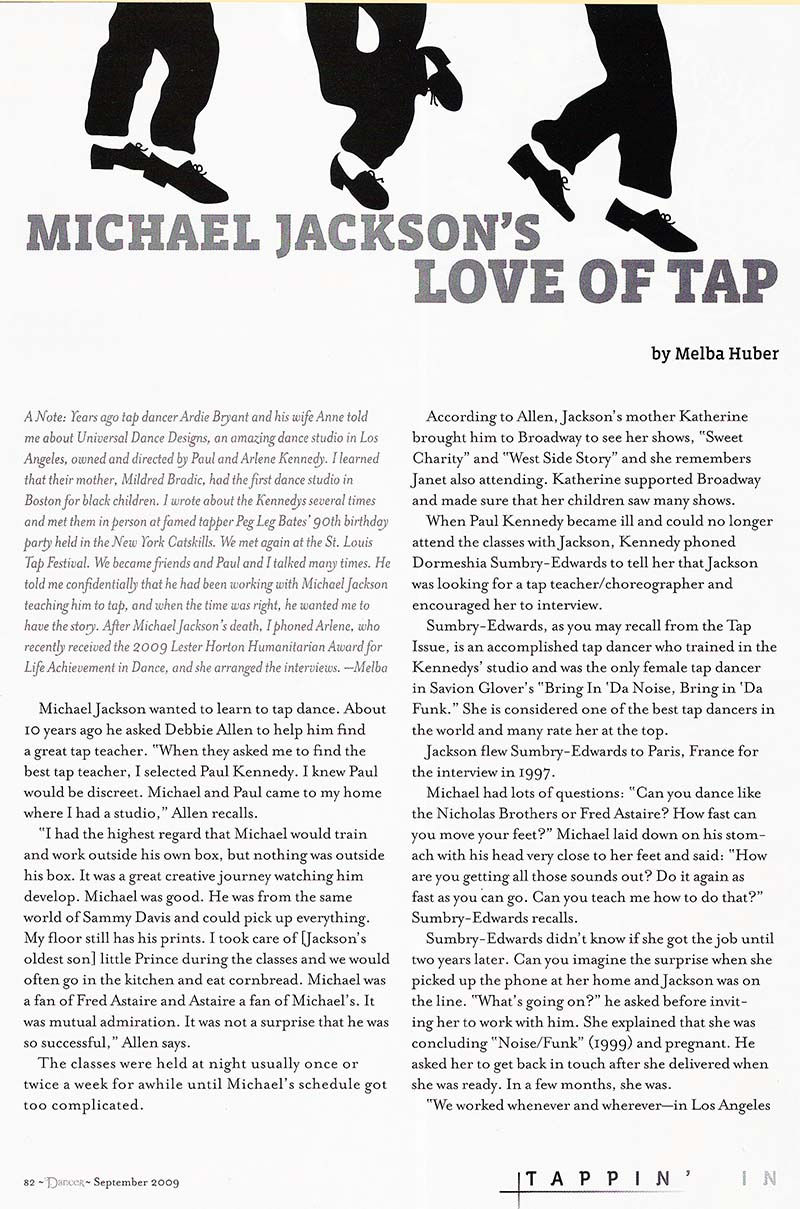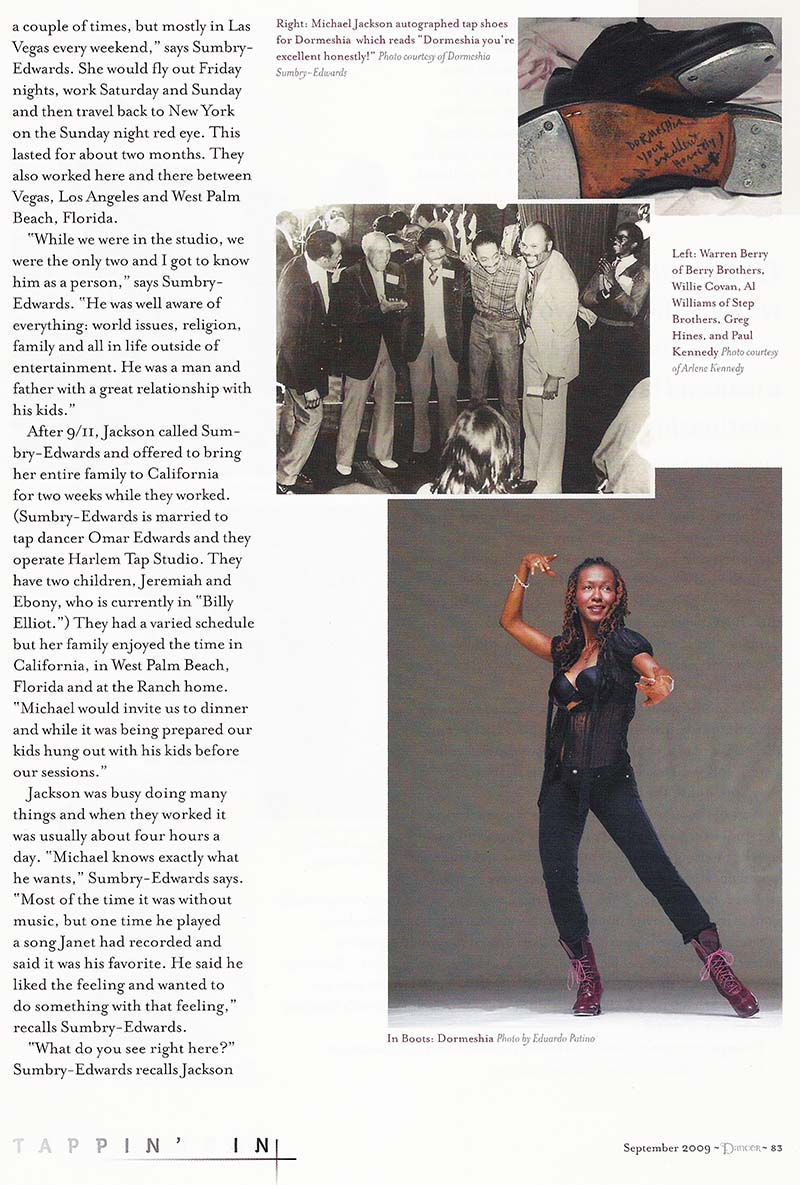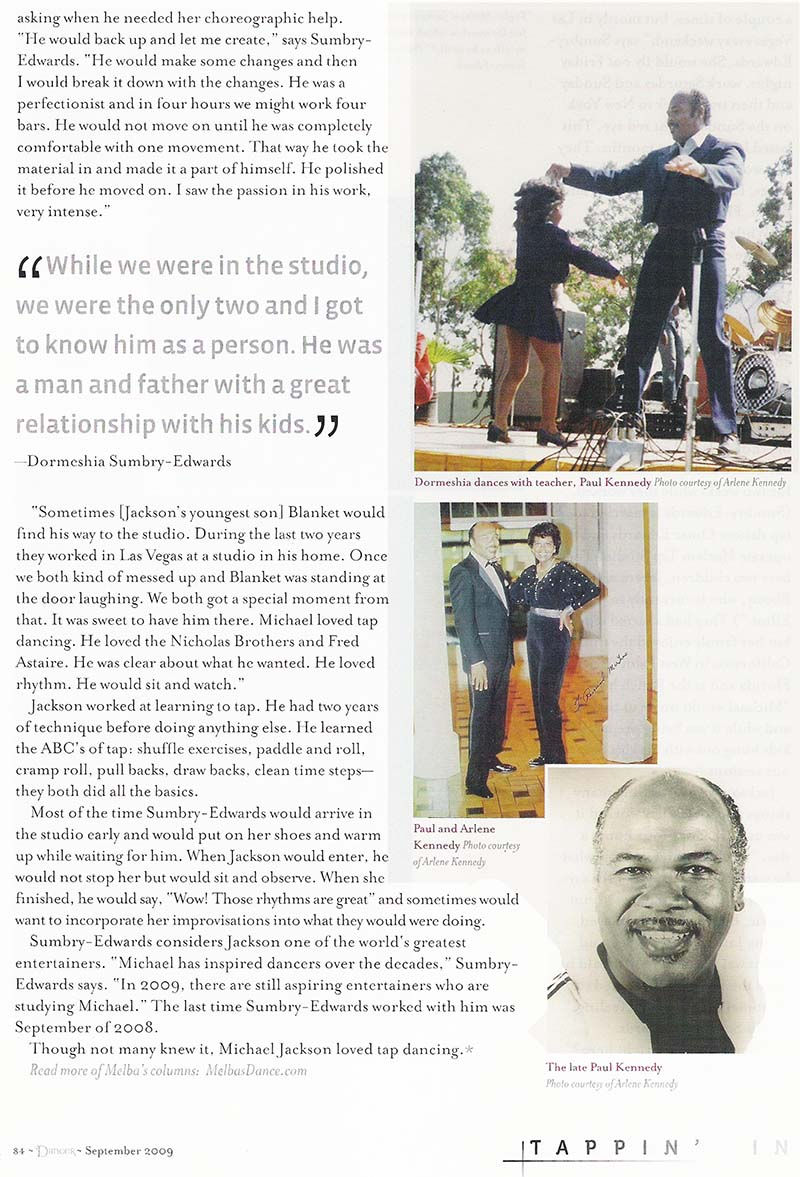Michael Jackson's Love of Tap
- Melba Huber
- Oct 2, 2009
- 4 min read
Updated: Aug 2, 2019



Michael Jackson wanted to learn to tap dance. About 10 years ago he asked Debbie Allen to help him find a great tap teacher. "When they asked me to find the best tap teacher, I selected Paul Kennedy. I knew Paul would be discreet. Michael and Paul came to my home where I had a studio," Allen recalls.
"I had the highest regard that Michael would train and work outside his own box, but nothing was outside his box. It was a great creative journey watching him develop. Michael was good. He was from the same world of Sammy Davis and could pick up everything. My floor still has his prints. I took care of [Jackson's oldest son] little Prince during the classes and we would often go in the kitchen and eat cornbread. Michael was a fan of Fred Astaire and Astaire a fan of Michael's. It was mutual admiration. It was not a surprise that he was so successful," Allen says. The classes were held at night usually once or twice a week for awhile until Michael's schedule got too complicated. According to Allen, Jackson's mother Katherine brought him to Broadway to see her shows, "Sweet Charity" and "West Side Story" and she remembers Janet also attending. Katherine supported Broadway and made sure that her children saw many shows. When Paul Kennedy became ill and could no longer attend the classes with Jackson, Kennedy phoned Dormeshia Sumbry-Edwards to tell her that Jackson was looking for a tap teacher/choreographer and encouraged her to interview. Sumbry-Edwards, as you may recall from the Tap Issue, is an accomplished tap dancer who trained in the Kennedys' studio and was the only female tap dancer in Savion Glover's "Bring In "˜Da Noise, Bring in "˜Da Funk." She is considered one of the best tap dancers in the world and many rate her at the top. Jackson flew Sumbry-Edwards to Paris, France for the interview in 1997. Michael had lots of questions: "Can you dance like the Nicholas Brothers or Fred Astaire? How fast can you move your feet?" Michael laid down on his stomach with his head very close to her feet and said: "How are you getting all those sounds out? Do it again as fast as you can go. Can you teach me how to do that?" Sumbry-Edwards recalls. Sumbry-Edwards didn't know if she got the job until two years later. Can you imagine the surprise when she picked up the phone at her home and Jackson was on the line. "What's going on?" he asked before inviting her to work with him. She explained that she was concluding "Noise/Funk" (1999) and pregnant. He asked her to get back in touch after she delivered when she was ready. In a few months, she was. "We worked whenever and wherever"”in Los Angeles a couple of times, but mostly in Las Vegas every weekend," says Sumbry-Edwards. She would fly out Friday nights, work Saturday and Sunday and then travel back to New York on the Sunday night red eye. This lasted for about two months. They also worked here and there between Vegas, Los Angeles and West Palm Beach, Florida. "While we were in the studio, we were the only two and I got to know him as a person," says Sumbry-Edwards. "He was well aware of everything: world issues, religion, family and all in life outside of entertainment. He was a man and father with a great relationship with his kids." After 9/11, Jackson called Sumbry-Edwards and offered to bring her entire family to California for two weeks while they worked. (Sumbry-Edwards is married to tap dancer Omar Edwards and they operate Harlem Tap Studio. They have two children, Jeremiah and Ebony, who is currently in "Billy Elliot.") They had a varied schedule but her family enjoyed the time in California, in West Palm Beach, Florida and at the Ranch home. "Michael would invite us to dinner and while it was being prepared our kids hung out with his kids before our sessions." Jackson was busy doing many things and when they worked it was usually about four hours a day. "Michael knows exactly what he wants," Sumbry-Edwards says. "Most of the time it was without music, but one time he played a song Janet had recorded and said it was his favorite. He said he liked the feeling and wanted to do something with that feeling," recalls Sumbry-Edwards. "What do you see right here?" Sumbry-Edwards recalls Jackson asking when he needed her choreographic help. "He would back up and let me create," says Sumbry-Edwards. "He would make some changes and then I would break it down with the changes. He was a perfectionist and in four hours we might work four bars. He would not move on until he was completely comfortable with one movement. That way he took the material in and made it a part of himself. He polished it before he moved on. I saw the passion in his work, very intense." "Sometimes [Jackson's youngest son] Blanket would find his way to the studio. During the last two years they worked in Las Vegas at a studio in his home. Once we both kind of messed up and Blanket was standing at the door laughing. We both got a special moment from that. It was sweet to have him there. Michael loved tap dancing. He loved the Nicholas Brothers and Fred Astaire. He was clear about what he wanted. He loved rhythm. He would sit and watch." Jackson worked at learning to tap. He had two years of technique before doing anything else. He learned the ABC's of tap: shuffle exercises, paddle and roll, cramp roll, pull backs, draw backs, clean time steps"”they both did all the basics. Most of the time Sumbry-Edwards would arrive in the studio early and would put on her shoes and warm up while waiting for him. When Jackson would enter, he would not stop her but would sit and observe. When she finished, he would say, "Wow! Those rhythms are great" and sometimes would want to incorporate her improvisations into what they would were doing. Sumbry-Edwards considers Jackson one of the world"˜s greatest entertainers. "Michael has inspired dancers over the decades," Sumbry-Edwards says. "In 2009, there are still aspiring entertainers who are studying Michael." The last time Sumbry-Edwards worked with him was September of 2008.
Though not many knew it, Michael Jackson loved tap dancing.








Comments